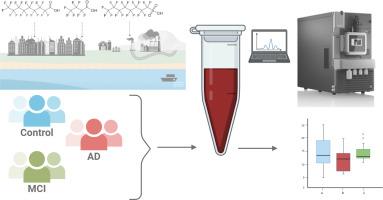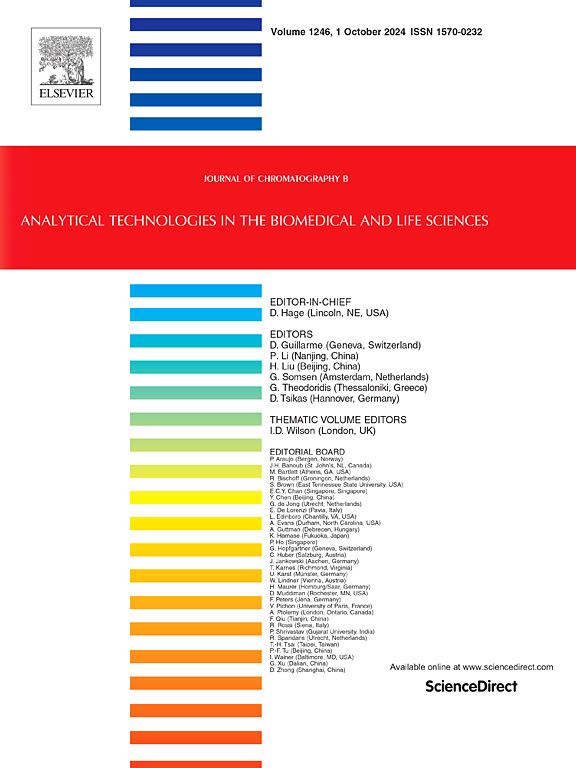UHPLC-MS/MS analysis of PFAS in the serum of patients with Alzheimer's disease, mild cognitive impairment and controls: A preliminary study
IF 2.8
3区 医学
Q2 BIOCHEMICAL RESEARCH METHODS
引用次数: 0
Abstract
Complimentary UHPLC-MS methods for 6 ultra short chain (polar) and 30 long chain (and relatively non-polar) PFAS compounds have been developed and used to profile these compounds in human serum. The methods were developed to be rapid, with both having analysis times of ca. 5 min, to enable the rapid screening of samples. Both methods were sensitive enough to detect the target PFAS over the range 0.5–50 ng/mL. These methods were then applied to the screening of the serum of 137 subjects comprising healthy controls (HC), subjects with mild cognitive impairment (MCI) and those with Alzheimer's disease (AD). These methods demonstrated the presence of the 33 of targeted PFAS in these serum samples, presenting over a wide concentrations range with PFPrA found at the highest maximum concentration of 707 ng/mL. Interestingly the PFAS profiles found for the HC and MCI subjects differed from those of the AD patients. The reason(s) for differences in the PFAS profiles obtained for serum from AD patients compared to HC/MCI subjects is unclear and may be unrelated to disease but clearly warrants further investigation to clarify the underlying reasons for this observation.

UHPLC-MS/MS分析阿尔茨海默病患者、轻度认知障碍患者和对照组血清中PFAS的初步研究
已经开发了6种超短链(极性)和30种长链(相对非极性)PFAS化合物的互补UHPLC-MS方法,并用于在人血清中分析这些化合物。这两种方法都是快速的,分析时间都在5分钟左右,可以快速筛选样品。两种方法均能在0.5 ~ 50 ng/mL范围内检测到目标PFAS。然后将这些方法应用于137名受试者的血清筛选,包括健康对照组(HC)、轻度认知障碍(MCI)和阿尔茨海默病(AD)受试者。这些方法表明,在这些血清样本中存在33种靶向PFAS,其浓度范围很广,PFPrA的最高浓度为707 ng/mL。有趣的是,HC和MCI受试者的PFAS谱与AD患者不同。与HC/MCI受试者相比,AD患者血清中PFAS谱差异的原因尚不清楚,可能与疾病无关,但显然需要进一步调查以澄清这一观察结果的潜在原因。
本文章由计算机程序翻译,如有差异,请以英文原文为准。
求助全文
约1分钟内获得全文
求助全文
来源期刊

Journal of Chromatography B
医学-分析化学
CiteScore
5.60
自引率
3.30%
发文量
306
审稿时长
44 days
期刊介绍:
The Journal of Chromatography B publishes papers on developments in separation science relevant to biology and biomedical research including both fundamental advances and applications. Analytical techniques which may be considered include the various facets of chromatography, electrophoresis and related methods, affinity and immunoaffinity-based methodologies, hyphenated and other multi-dimensional techniques, and microanalytical approaches. The journal also considers articles reporting developments in sample preparation, detection techniques including mass spectrometry, and data handling and analysis.
Developments related to preparative separations for the isolation and purification of components of biological systems may be published, including chromatographic and electrophoretic methods, affinity separations, field flow fractionation and other preparative approaches.
Applications to the analysis of biological systems and samples will be considered when the analytical science contains a significant element of novelty, e.g. a new approach to the separation of a compound, novel combination of analytical techniques, or significantly improved analytical performance.
 求助内容:
求助内容: 应助结果提醒方式:
应助结果提醒方式:


